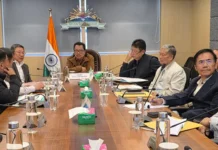[ SC Mohanty ]
India-China disengagement at the LAC announced by Indian foreign secretary Vikram Misri on 21 October has reportedly already begun and is to be completed by 29 October. It is a positive development after four and a half years of sustained, painstaking and arduous negotiations at the military and diplomatic levels.
Jaishankar reiterated restoration of India’s access to the patrolling points as was before June, 2020. While earlier disengagements at Galwan, the north bank of Pangong Tso, the Kailash range and the Gogra-Hot Spring area had happened progressively till 22 September, the main sticking disagreements at strategic locations of Depsang and Demchok had remained ostensibly due to mutual vulnerabilities of DBO and DSDBO road on Indian side and G 219 highway on the Chinese side.
It may be pertinent to note that the announcement of disengagement came on the eve of the BRICS summit in Kazan in Russia. Coincidentally, similar disengagement had happened at the Gogra hot spring prior to the SCO summit in Samarkand in 2022 and earlier at Doklam prior to the BRICS summit in September 2017 in China after a 73 days stand-off.
It is imperative to recall the incidents leading up to the disengagement which, as per reports, will restore Indian prerogative to move up to patrolling points (PP) along the LAC, synonymous with our claim lines. Blocking of access to the PPs and buffer zones were construed as loss of territory. The economic survey of 2024 suggested that India should welcome Chinese foreign investment to boost manufacturing, increase exports, reduce imports from China and strengthen role in global value chains. On 12 September, Foreign Minister Jaishankar had mentioned that 75% of the disengagement problems with China had been resolved. India had maintained that restoration of peace and tranquillity along theborder is a prerequisite for normalisation of relations.
The Chinese are not known to make border concessions which they consider core interests involving sovereignty. It has passed three laws; the Land Boundary Law, effective from 1 Jan, 2022, the Coast Guard Law, effective from 1 February, 2021 and the Maritime Traffic Safety Law, effective from 1 September, 2021 to justify its assertive posture and resolve its land and maritime disputes on its preferred terms.
It has violated border-specific agreements with Indiain 1993, 1996, 2005 and 2013 and amassed troops along the LAC, making selective intrusions into sensitive areas, following its strategy of claim, occupy, legitimise and integrate. Over the past four years it has made extensive dual use infrastructure developments close to the LAC, including Xiaokang (well off) villages, permanent habitats, roads, bridges, storage sites, heliports, airfields and even a pier on the Pangong Tso.
Consequent to disengagement and de-escalation at Doklam in 2017, the Chinese have vastly improved military infrastructure on its side of the LOC with the option of attempting another foray towards Jampheri ridge, concurrent with border negotiation with Bhutan. What then are the current compulsion towards a climb down?
# China is possibly at its weakest economic, military and diplomatic stature in over a decade. It has suffered relentless pushback from the US on trade and high-end technology, which is likely to get worse if Trump comes to power.
# Its economic relations with EU, UK and Australia is facing headwinds due to tariffs and counter tariffs and the IMF downgrading its GDP growth to 4.8 percent.
# The South China Sea is increasingly contested and militarised with a resolute Philippines, Japan, Vietnam and even ASEAN calling for a rules based international order based on UNCLOS.
# Internally, its unemployment has reached unprecedented levels, exodus of foreign direct investments and declining property sector that contributed nearly 30 percent of GDP has had a debilitating effect compromising its aspiration to match US as a global power.
# There is growing discontentment/implosion within the PLA due to large scale purging of senior officials including ministers leaving Xi Jinping nearly isolated.
India’s growing military, economic and diplomatic stature in the geostrategic and geoeconomic arena provides it an opportunity to negotiate from a position of assertive equivalence. It is preposterous for China to maintain and sustain its belligerence along the LAC. Concurrently, India is keen to maintains its strategy of multi-alignment (SCO,BRICS, QUAD,G20) to contribute to its comprehensive national power.
While disengagement commenced on 24 October, 2024 from stand-off points in Depsang and Demchok, the Army chief has alluded to restoration of trust and sanctity of buffer zones. India needs to maintain a credible and demonstrative deterrent posture all along the LAC to prevent a Galwan 2.0
# The instant agreement apparently deals with patrolling rights in Depsang and Demchok and does not include buffer zones of 3-10 km(largely on own side) created in areas of Galwan, Gogra Hot spring, Pangong Tso and Kailash Range. Status quo ante would mean rights as existed prior to April 2020. India must unequivocally insist on this arrangement.
# The earlier agreements on border issue have been jettisoned by China through its belligerent behaviour in 2020. There ought to be a new framework that is inviolable with attendant costs for non-compliance. Hardnosed negotiations are imperative.
# India must maintain a robust all weather technology driven and multiple means of ground and aerial surveillance 24/7 to monitor Chinese compliance to the agreement.
# Maintain matching mobilization timings and operational resilience for troops and equipment reacting to criticalities at various points on the LAC. This will be dynamicas PLA troops build up for exercises or turnover.
# Relocation of mechanised forces, artillery, aviation and other combat support assets must be based on verifiable actions by PLA. Terrain being dissimilar on either side, it is the time taken for build up at critical points that is crucial. It is essential to maintain a coercive content in the defensive layout as demonstrated at Kailash Range. This would mean reappropriation of forces from the Western Sector and less threatened sectors in the valley would persist.
# The rules of engagement, which were violated by the PLA troops using nail and spike studded clubs at Galwan needs to be unambiguously defined. During patrolling to the designated locations, reserve patrols of adequate strength be echeloned in mutually supporting distances to respond to any unforeseen contingency in a competitive time matrix. This would be predicated on proportionate capability of the PLA’smischievous obfuscation at various points along the LAC. Control over an unintended escalatory spiral for de-escalation is of great consequence.
# There can be no compromise on the dominating ridgeline held in Arunachal Pradeshas is being reported; including Yangtse, Asaphila, FishtailsI and II, having already lost out on Thagla Ridge and Longju held by PLA.
# Future negotiations with the Chinese at the WMCC level ought to have a military representative as was the case for Corps Commander level talks where a joint secretary level officer from ministry of external affairs attended.
# Return of normalcy/stability along the LOC must be a catalyst for sustained and result oriented negotiations to settle the boundary dispute. This must include exchange of maps depicting claim lines and historical linkages. It can no longer be the can to be kicked down the road.
# There can be no pause/laxity in the ongoing development of border infrastructure including alternative axes, tunnels, bridges, roads, aviation assets and habitat. The Vibrant Village Programme must be continued with full gusto and vigour. India must not yield to Chinese pressure to slow down border infrastructure.
# While Chinese investment in Indian manufacturing sector and pharmaceuticals is essential to sustain/enhance economic growth, the same cannot be at the cost of national security interests. Atmanirbharta, import substitution and diversification efforts must be pursued with urgency to reduce dependence on foreign sources in critical sectors.
# Investments in vulnerable sectors lending itself to technical intrusion (IT equipment, communication) must be prevented. Market access must be reciprocal to include medium and low end technology.
# Reciprocity must define cooperation in the multilateral fora. Jaishankar had brought out the issue of double standards, especially with respect to terrorism at the BRICS summit at Kazan.
The trust deficit, which has reached unprecedented levels, will need time to redeem based on verifiable actions on the part of Chinese. The asymmetry in the comprehensive national power has to be progressively attenuated through military modernisation, technological upgradation, diplomacy and selective multi alignment. (The contributor is a retired major general.)



